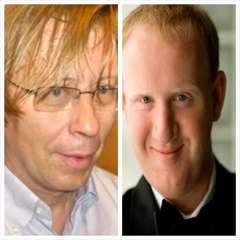|
Back
When Haas Should Have Met Schoenberg New York
Weill Recital Hall, Carnegie Hall
02/28/2014 -
Wolfgang Amadeus Mozart: Quintet for Piano and Winds in E-flat Major, K. 452
Georg Friedrich Haas: Anachronism (New York Premiere)
Arnold Schoenberg: Verklärte Nacht, Opus 4
Ensemble ACJW: Stuart Breczinski (Oboe), Liam Burke (Clarinet), Nanci Belmont (Bassoon), Laura Weiner (Horn), Tyler Wottrich (Piano), Grace Park, Clara Lyon, Michelle Ross (Violins), John Stulz, Megan Griffin (Violas), Hannah Collins (Cello) Doug Balliett (Bass)

G.F. Haas, T. Wottrich (© Coco T.Dog/Courtesy of the Artist)
While usually relishing the Weill Recital Hall, with its cream-white interior and its glittering chandeliers, the Baroque-style auditorium was appropriate for only a single work last night in their concert by the Ensemble ACJW.
Mozart’s Quintet for Piano and Winds was made for this hall. Rarely played in New York, since its ensemble can be used only for this and the Beethoven Quintet, the piece has a memorable charm, delicious memories and–most of all–the individual tonal palaettes which Mozart loved best. He didn’t have to worry about a shrieking flute or pleasing a diva fiddler. Instead, he had his four favorite winds, a piano to bring them together, and, here, three movements which sung with a variety of timbres.
The composer himself, almost into his final period, considered it be “the best work I have ever composed.” History might question the personal hype, but there was doubt he had a lovely time writing it.
The five players of ACJW were top-rate as soloists., But more important, they obviously loved painting with their duets. Clarinet and horn, bassoon and oboe, in all their permutations, gave Mozart sheer joy, and these artists as well. The opening movement was opened majestically (did ACJW plan a tragic overture?), and then swung into a vernal Allegro moderato, followed by a seemingly innocent Larghetto. Toward the end, the five players took half-breaths and changed the whole mood, as if Mozart, having too much fun, decided to he had to point out that even lights have shadows.
Pianist Tyler Wottrich was behind them in those two movements, but he shone in the final Rondo, not only as a soloist, but in leading a five--player cadenza.
The only criticism I can have is that the players were consciously too good, that at times they didn’t let Mozart roll along his way, but insisted on pointing out every note, every phrase.
The same players, with violin and bass gave the world premiere of a work written by Georg Friedrich Haas, commissioned by Carnegie Hall itself. As bassist Doug Balliett explained, “We had a blast rehearsing this.”
And as the composer himself–typically self-effacing and ebullient–explained, he had been influenced by comic paintings of Roy Lichenstein, “breaking up the flattened plains of the painted models into the dynamics of points and colored circles.”
I doubt if Weill Recital Hall had the right architecture for Anachronism. Architecture from the Age of Reason paled behind a non-stop 13 minutes with the instruments seemingly repeating themselves, harmonies and colors changing. But we actually had two meters within measures, an 11-note theme and (seeming) triplets above or below that theme, all pulsing, pushing, altering themselves, progressing and retarding. All took place before the last 30 seconds of near-quietness, a solitary ending to the joy-ride.
Then again, Mr. Haas always attempts originality, so Anachronism was exactly what we expected from the composer. In fact, it was closer to Steve Reich than what we expect of Mr. Haas. He is producing much during his American sabbatical, and this was perhaps not the most subversive of his sparkling catalog.
Where we really needed Georg Friedrich Haas’s inspiration was the Arnold Schoenberg “Transfigured Night.” Schoenberg had made several arrangements of his works, some of them–like the Vienna Philharmonic’s Friede auf Erden last Tuesday–not entirely to their advantage. But this was the original string sextet of Schoenberg’s obsessionally tormenting poet. The music is lean, haunting, sometimes elegiac, more often haunting.
The artists here played it well, they had the nuances right, the intonations followed the score. Yet–and I confess my shortcoming–I simply couldn’t look at the players. One young man in a proper suit, four young ladies, one of them actually perky. None of them exactly appropriate to this most private musical confessional.
This would have been the time for Mr Haas to add a suggestion. The composer, so sensitive to the physical light and darkness around his work, could have advised that the five artists memorize their scores and then put the entire Weill Recital Hall into total darkness.
No matter how agreeably played, this is music is neither somber nor pleasant. It is a series of confessions and emotional apparitions in a moon-radiant forest. The lovely playing here wasn’t quite enough to move us in this post-Wagnerian late Romantic musical threnody.
Harry Rolnick
|